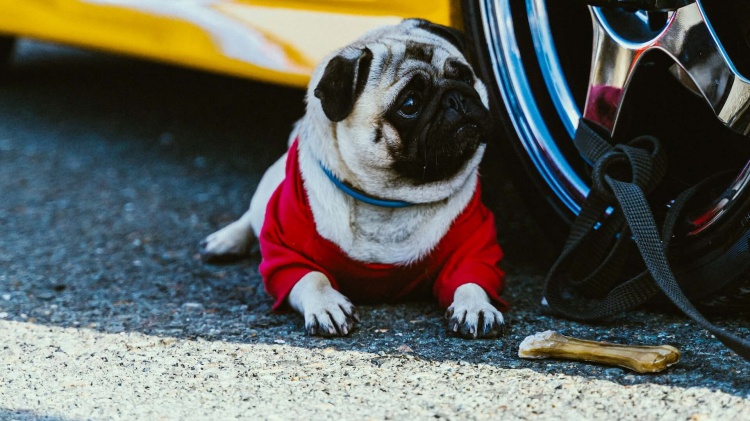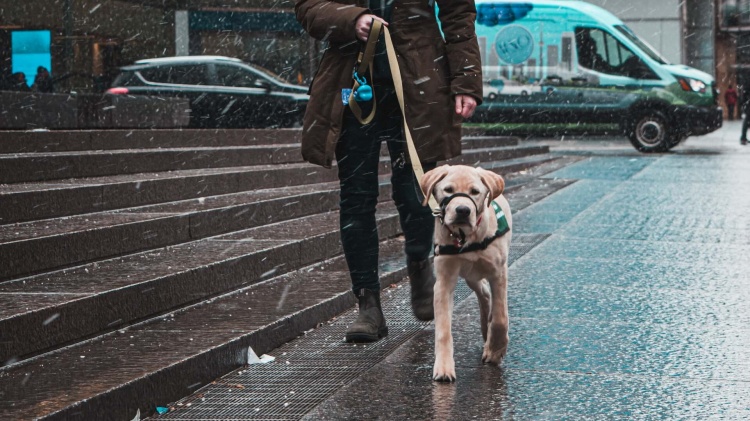Training your dog to use stairs for cars is an essential aspect of ensuring their safety and comfort during car rides. Whether you have a small breed that can’t quite make the jump, an older dog with joint problems, or a pup that’s simply hesitant to climb in and out of the vehicle, a set of dog stairs can be a game-changer.
However, introducing your furry friend to this new equipment can sometimes be a challenge. In this guide, we will provide you with five practical tips to help make the training process as smooth and stress-free as possible.
From choosing the right set of stairs to positive reinforcement techniques, we’ve got you covered. Our goal is to help you and your pet enjoy car rides together, without the worry of potential injuries or discomfort.
So, whether you’re planning a road trip or simply want to make daily car rides easier for your pet, these tips will set you on the right path.
Let’s dive in and explore the best ways to train your dog to confidently and safely use stairs for cars.
1. Start indoors first
Begin introducing your dog to the stairs in a controlled, familiar environment indoors. This gets them comfortable with the stairs before tackling the additional challenges of vehicles.
Use low settings first
- Place the stairs on the lowest settings to start, just 1-2 steps high.
- Let your dog explore and reward any interaction with treats and praise. Sniffing and touching are great first steps.
- If your dog is very unsure, place treats on the actual stairs to encourage stepping on them.
Practice up and down
- Guide and reward your dog for walking up the stairs at this low height, turning around at the top, and slowly descending.
- Go at your dog’s pace, providing support and encouragement. Use a harness if needed.
- If your dog is reluctant to descend, walk backward facing them.
Increase height gradually
- As your dog masters the lowest height, gradually increase stair height over multiple sessions.
- Add just a couple of inches each time, ensuring continued success.
- Keep sessions short, ending on a positive note. Gradually extend session duration.
Starting low inside builds confidence and lets your dog learn proper stair technique in a safe, enclosed space first. This removes uncertain factors they’ll experience outside.
2. Support your dog physically
Dogs feel more secure conquering stairs with some physical support and guidance. Use these methods to keep them steady:
Harnesses
- Use a well-fitted imbracatura attached to a lead to gently guide your dog up and down the stairs.
- The lead allows controlling speed and movement, preventing rushed descents.
- Make sure to size the harness properly so it doesn’t shift or choke when pulled.
Hands-on support
- Spot your dog by gently holding their collar or body as they ascend training stairs.
- Slowly decrease hands-on support when your dog demonstrates confidence and accuracy.
Barriers
- Place barriers like baby gates, rails, or boxes along the sides for your dog to press against if needed for reassurance.
- This prevents sideways slips and gives added stability.
Providing multiple points of physical contact boosts confidence when first working on stairs. Remove supports gradually as skills improve.
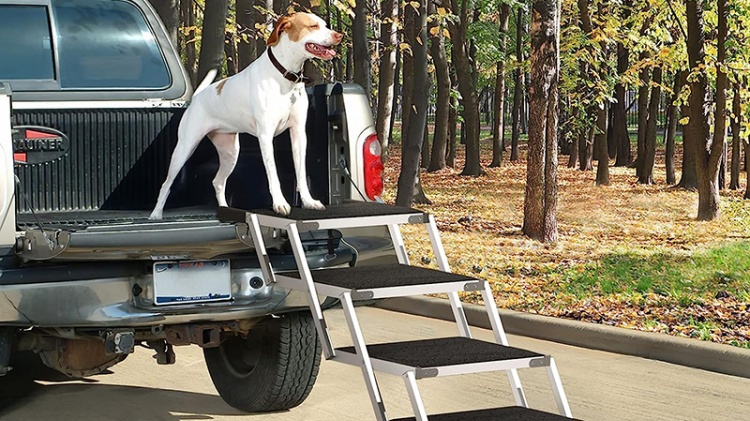
3. Use verbal cues and treats
Verbal praise, commands and motivation are equally important when acclimating your dog to stairs.
Reward verbally
- Use an excited, happy tone when your dog takes steps successfully.
- Couple verbal praise like “Good dog!” with affectionate pets and rubs.
Treats for motivation
- Place treats on stairs to entice your dog into stepping on them.
- Reward with treats for every couple of stairs climbed early on.
Cue commands
- Use clear commands like “Up” and point upward to direct ascending.
- Say “Down” and signal downward for going downstairs.
- Praise and reward when they follow the cue properly.
Positive verbal cues motivate your dog and help direct proper stair techniques. Reduce food rewards gradually over time.
4. Practice with distractions
Dogs need to learn to take stairs properly even when distracted. Simulate real-world situations:
Noises
- Have a helper rattle keys or crinkle bags while your dog uses the stairs.
- Reward continued focus on the stairs and not being startled by sounds.
Being left
- Walk away or have your dog do stairs alone for short periods.
- Reward calm, independent stair use without you present.
New locations
- Slowly move training to different rooms and environments like the garage.
- Praise calm stair use in each new location.
Add people
- Have strangers approach slowly while your dog takes the stairs.
- Give treats for ignoring people and focusing on the stairs.
Gradually adding distractions provides important proofing so your dog remains focused when it really counts.
5. Take it slowly
Rushing any part of stair training can lead to accidents and fear. Allow your dog to set the pace:
No forcing
- Never pull, push or force your dog into taking steps if they resist. Just pause and rebuild trust.
- Remain calm and patient. Work at their comfort level.
Break it down
- Focus initial sessions on small milestones like just 4 steps, or just up, or just down.
- Stitch short successful repetitions together into longer stair mastery.
Watch for fatigue
- End sessions before your dog shows any signs of trembling, panting or exhaustion.
- Multiple short sessions are most effective for stair training.
Let your dog gain confidence at their own pace. They will eventually connect the dots into stair expertise. Patience prevents problems down the road.
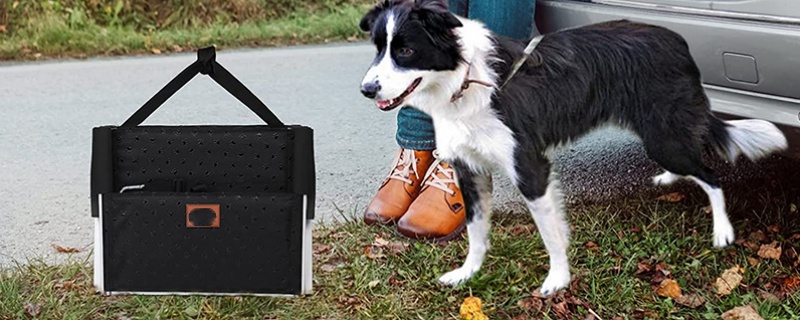
Final tips
With this stair training approach focused on safety, patience and praise, your dog will transition from stair uncertainty to stair expertise. Keep these points in mind:
- Provide more support early on, removing it gradually as skills improve.
- Make sessions feel like a positive game rather than a chore.
- Consistency builds confidence. Practice a little every day.
- Upgrade to larger, sturdier stairs as your dog grows.
- Well-fitted non-slip harnesses help ensure control and stability.
- Seek advice from trainers if your dog struggles with any aspects.
- Once mastered indoors, train outside to steps, porches, and decks.
- Outdoors introduce car sounds and activities the dog will encounter.
- Check stairs for stability and grip regularly. Dogs sense if stairs are precarious.
- Keep early vehicle access low like ramps or low tailgates until stair expert.
- Teach stair manners – no shoving other pets or rushing up/down.
With dedication, patience and care, your dog will be comfortably and safely taking car stairs in no time. Enjoy the rides ahead!
Why dog car stairs are useful
Dog car stairs provide important benefits beyond just vehicle access. Understanding these advantages can further motivate training.
Preserves health
Stairs allow low-impact entry that prevents joint strain from jumping.
This reduces the risk of hip and joint injuries, especially for senior dogs.
Provides independence
- Dogs can enter vehicles without being lifted or carried.
- This preserves dignity and confidence in aging pets.
Safer than human stairs
- Wider, deeper stairs are designed for canine proportions and abilities.
- Dogs may struggle on steeper, narrower human stairs.
Versatile uses
- Dog stairs can be used for furniture access, etching into beds, pool entry, etc.
- Multi-purpose functionality gets your investment dollars stretching further.
Peace of mind
- Dog parents enjoy the security of safe, easy vehicle entry for their pets.
- Avoid worries about pets falling or escaping from vehicles.
The benefits go well beyond just getting your dog in and out of the car. Dog stairs support health, safety and independence for current and future years.
To make stair training success as easy as possible, invest in an appropriately sized and featured set of dog stairs.
Measure vehicle height
- Measure ground to vehicle floor height where your dog will enter.
- Choose stairs slightly shorter than this height.
Weight capacity
- Make sure the stairs meet or exceed your dog’s weight.
- Heavier dogs need greater weight limits for safety.
Stair depth and width
- Measure your dog’s body size to ensure steps accommodate.
- Growing puppies need wider, deeper stairs to match their adult builds.
Materials
- Select non-slip, weatherproof materials for durability.
- Steel and hard plastics provide the most stability.
- Ensure steps have textured, grooved surfaces.
Properly fitting, well-built stairs tailored to your dog’s needs will give them the highest odds of stair training success.
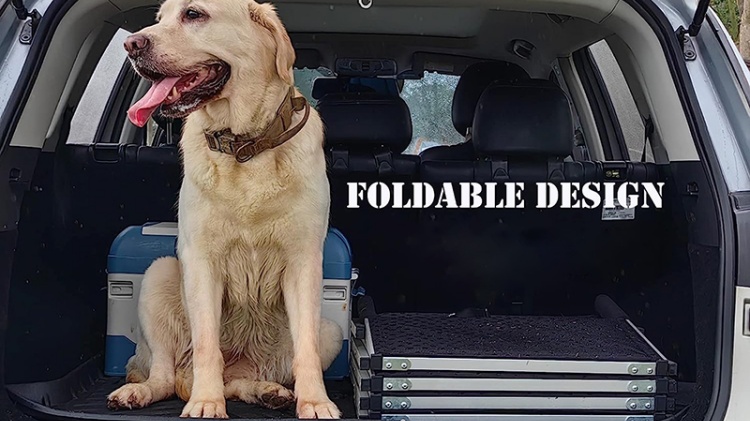
The real world uses tips
Once initially trained on stairs, here are some tips for real-world use:
Use anchors
Always firmly secure stairs to vehicles using anchors or bungees.
Mind slip hazards
Avoid using stairs on slick surfaces like ice or smooth metal truck beds.
Stay close
Keep hold of the leash or your dog when using vehicle stairs.
Add support when needed
Use harnesses or slings to support elderly, injured or unstable dogs on stairs.
Don’t rush
Remind dogs to take the stairs slowly. Rushing leads to accidents.
Check conditions
Monitor for signs of pain or difficulty – adjust stairs or discontinue use.
Stay consistent
Frequent stair use keeps dogs confident. Infrequent use leads to uncertainty.
Continuous safety, patience and praise ensures your dog utilizes their stairs safely for years. Enjoy the destination ahead!









